|
Location:
South Pacific Coast,
Costa Rica. |
Grid Reference:
Costa Rica. |
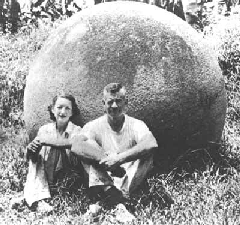
 The Costa Rica Stone Balls:
(Stone Petrospheres).
The Costa Rica Stone Balls:
(Stone Petrospheres).
Described by
Columbus as the 'Rich Coast'. Over 300 of the carved stone balls
have so far been discovered. The stones are believed to have been
carved between 200 BC and 1500 AD. However the only method available
for dating the carved stones is stratigraphy, and most stones are no
longer in their original locations. They spheres range in size from
a few centimetres to over 2 metres (6.6 ft) in diameter, and weigh
up to 16 short tons (15 t). (1)
Most are sculpted from gabbro,
the coarse-grained equivalent of basalt. There are a dozen or so
made from shell-rich limestone, and another dozen made from a
sandstone.
Photo:
Archaeologist Samuel Lothrop pictured with his wife Eleanor
during their investigation of sites in the Disquis Delta
in 1948.
The first written testimonial of the
petrospheres is
from the Spanish Conquistador
Francisco Pizarro in 1547:
�I
have heard that the elders of the
realm assemble around the stone
spheres, where they receive advice
from the sages.�
Background:
Dr. Stone (1943), Verneau and Rivet (1912-1922) and others
discussed the distribution of stone balls, large and small,
throughout the New World. They concluded that the spheres
served different functions in different areas. Large examples
outside the delta area are rare. Isolated specimens up to 3 feet
in diameter are known from Olmec sites in Vera Cruz Mexico. They
have also been reported at Zaculeu in the Guatemalan Highlands
(largest 15 1/2 inches in diameter), occurring in the first
level of occupation in what is regarded as Early Classic Maya.
(3)
It is noted in this respect that
there are no 'stone-heads' in Costa Rica, of which there are
several in Mexican Olmec sites, so the two cultures were likely
unrelated.
(More
about the Olmec Stone Heads)
Context:
There are only a handful of petrospheres still in their
original settings, so we have little context within which to
place them. A program is underway to try and replace or at least
recognise more of the original locations for the balls, many of
which were recorded by Doris Stone. Small (10 and 24 inches) stone balls
have been found individually in
burial mounds and in at least 2 instances, balls were
placed in graves indicating individual ownership. Sometimes
balls occurred singly, other times in groups. The largest group
known to Lothrup contained at least 45 balls. Depressions in
which balls previously stood could still be detected at the time. Some
spheres were buried. Another interesting aspect of some balls,
was that a small number had residual lime coatings, suggesting
they might have been used as beacons in the forest
(3).

Reports say that
they were often found in groups of three, in the shape of a
triangle, and always placed in the North-South direction. The
layout of the stones above was recorded by S.K. Lothrop. Spheres
E and F are now in the Museo Nacional in San Jose, Costa Rica.
Making the
Balls: The rock-source for the Costa Rica balls is both from far and near. There is a
local Limestone called Coquina, located near the mouth of the Diquis
River which was used to make some of the smaller spheres. Even
though it is relatively close, it was still transported several miles. The
larger spheres have an igneous granite rock source, of which the croppings come from across rugged terrain over 50 miles away high up
in the Talamanca Mountains.
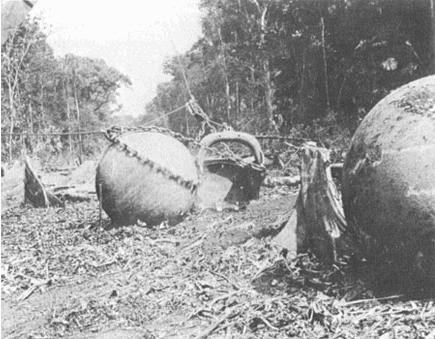
Archaeologist Doris Z. Stone
photographed these round stones being shifted during jungle
clearing to make way for railway tracks that would service
the United Fruit Company banana plantations (Photo: 1943).
At this time then,
very little can be said to be known about the origin or purpose of
the Costa Rica stone balls. There is no question that they were
manmade, and each would have required huge investments in both time
and labour to transport and shape. While it is most likely that they
served as a symbols of ritual or status, their artistic merit is not
to be ignored. The simplicity of these vastly sized spherical stones
on the landscape is both pleasing to the eye comforting in its
contrast to a natural background. Perhaps this in itself was the
reason for their existence.
|
The Stone Spheres as a
UNESCO WORLD HERITAGE Site:
In 2010 University of Kansas researcher John Hoopes visited the
site of the Stone Spheres to evaluate their eligibility for
protection as a Unesco World Heritage Site. One hopes that his
efforts will lead towards their protection in the future. As he says
himself:
"The balls have been endangered
since the moment of their discovery. Many have been
destroyed, dynamited by treasure hunters or cracked
and broken by agricultural activities. At the time
of a major study undertaken in the 1950s, fifty
balls were recorded as being in situ. Today,
only a handful are known to be in their original
locations".
"The earliest reports of the stones come from
the late 19th century, but they weren't really reported
scientifically until the 1930s � so they're a relatively recent
discovery," Hoopes said. "They remained unknown until the United
Fruit Company began clearing land for banana plantations in
southern Costa Rica."
"We date the spheres by pottery styles and
radiocarbon dates associated with archaeological deposits found
with the stone spheres," Hoopes said. "One of the problems with
this methodology is that it tells you the latest use of the
sphere but it doesn't tell you when it was made. These objects
can be used for centuries and are still sitting where they are
after a thousand years. So it's very difficult to say exactly
when they were made."
"We think the main technique that was used
was pecking and grinding and hammering with stones," said Hoopes.
"There are some spheres that have been found that still have the
marks of the blows on them from hammer stones. We think that
that's how they were formed, by hammering on big rocks and
sculpting them into a spherical shape."
(Click here
to visit Hoopes Website:
http://web.ku.edu/~hoopes/balls/) |
Gallery of Images: The
Costa Rica Petrospheres.

Musee
National du Costa Rica.
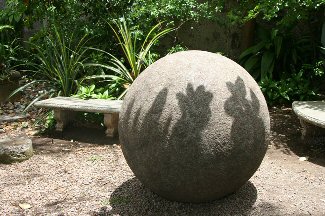
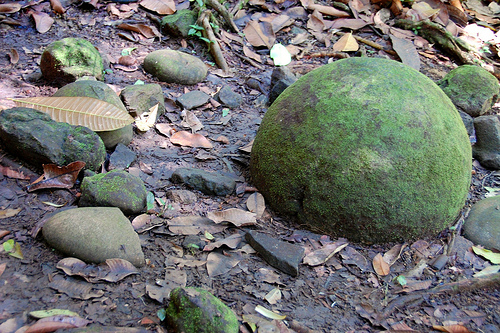
Above Right: Isla
Del Cana.
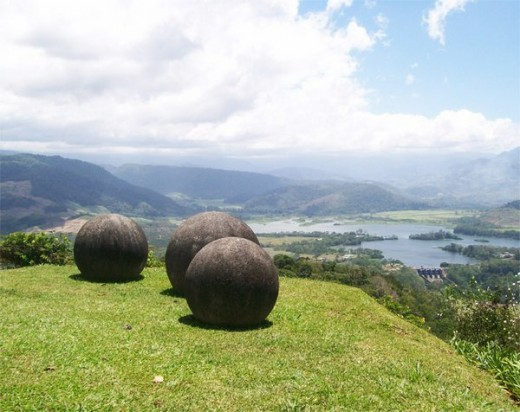
Other Stone Balls
(Petrospheres)
Other stone spheres have been reported to have been found in Bosnia, West Mexico,
Easter
Island, Scotland, United States
(Joshua Tree National Park), central Serbia and Japan (Nishijima
Islet, Hypogo Pref. And at Yamazoe village, Nara Pref).
(Petrospheres
Homepage)
(Olmec
Stone Heads)
(Other
Anomalous Artefacts)
(Pre-Columbian
Americas Homepage)
|